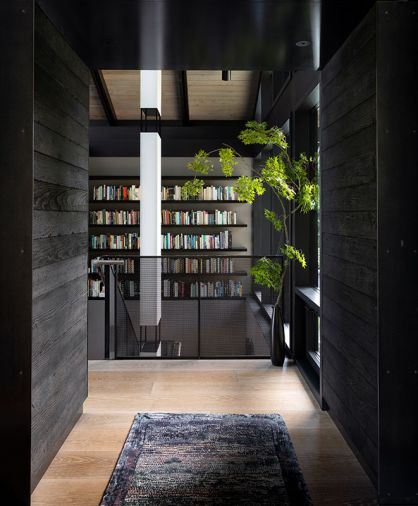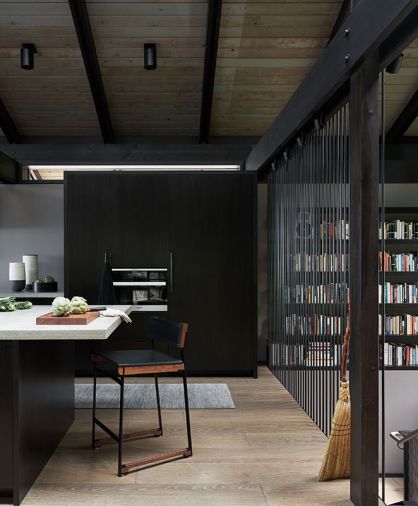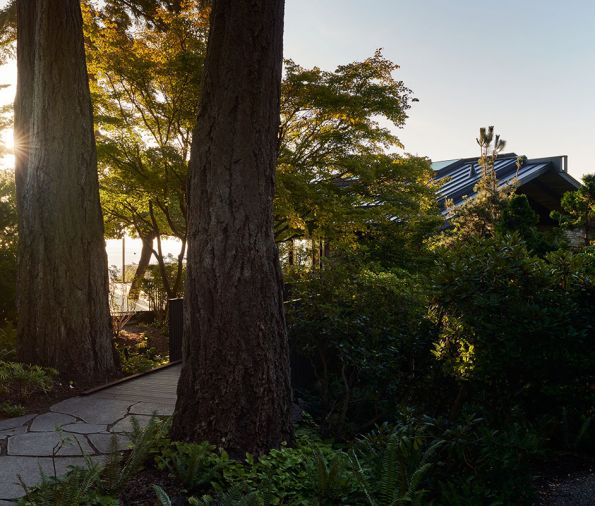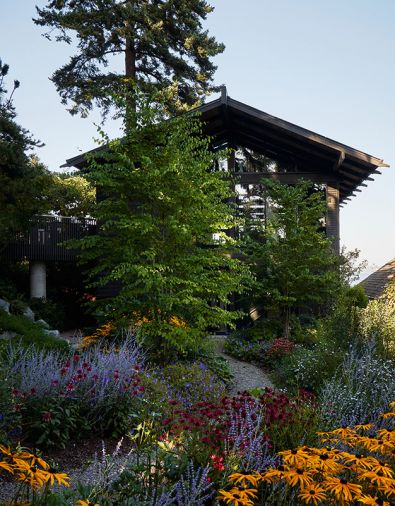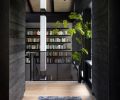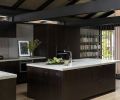This little piece of architectural heaven perched upon a bluff overlooking Puget Sound might appear as if it has gone untouched since architect Hal Moldstad first designed it in 1968. Nothing, however, could be further from the truth. In fact, to realize their vision of building a beautiful home amidst the canopy of 100-year-old+ evergreens, the new homeowners turned to Charlie Hellstern Interior Design with whom they had worked on multiple other homes to put together an excellent team that included The Miller Hull Partnership, known experts in the Living Building Challenge (LBC). Thus, began what architect John MacKay calls the ripple effect. “Like throwing a stone in water,” he says, “the owners’ dedication to LBC wasn’t merely to achieve a certificate for their home alone. Instead, their goal was to spur sustainable renovations to existing single-family homes.”
Moldstad’s original design featured two structures joined by a shared deck. The single-story north house, known as “Skoshi,” held a billiards room, while the two-story south house was a warren of small rooms above a garage. Because visitors were often confused about which house to turn to first, the team, who had gathered to discuss where to site a new carport, decided to create a new entrance to the home altogether. Anne James, the team’s landscape architect, recounts how a portal between a pair of giant evergreens became the new entrance via a floating bridge over the existing landscape of lush Japanese maples and rhododendrons.
The team at Clark Construction, Inc., founder Rachele Turnbull, Project Engineer Tina Song, and Superintendent Justin Ansley, were tasked with following the strict LBC guidelines. “Some architects shoot for just one of its 7 Petals, such as net positive energy, i.e., not consuming more than you generate,” notes Song, “but when you throw additional petals into the mix: water systems, and red-list-free-materials, it’s more demanding.”
Clark Construction was also responsible for dismantling by hand existing elements such as built-in bunkbeds, basement wood paneling, and exterior cladding. “They removed every single nail from the siding,” says MacKay. “Not damaging a 50+ year old board, storing it and then reinstalling it over a new exterior weather barrier, wrapped much tighter for today’s performance standards, is remarkable.”
The restructuring of the south house, which Clark Construction took down to the studs, epitomizes the conceptual and physical elements of the aptly named Loom House. Working with a structural engineer, Miller Hull “wove” its two stories together with a curtain of steel acting as a safety guard rail between floors. “The stairs did not exist previously,” explains MacKay, who had the original concrete floor demolished to create a new polished concrete one with radiant heat. Throughout it all, the team had to vet every single product used on the site to assure it wasn’t red listed, a sometimes-nerve-wracking job. “If something was installed on a weekend that had been on the Red list,” says Ansley, “it would have been tough to get out.”
The team embraced the home’s original darker palette, compressing the south house entry with a Shou Sugi Ban finish on the exterior wood cladding that now wraps the entry. There, a two-story paper lantern by Stefan Gulassa illuminates the connection between the floors, while subtly blocking the neighboring property. “We love how open we made things,” says Hellstern, “with steel mesh on the stair railings, timber dimensional stair treads and a finish on the upstairs wood floor resembling driftwood.”
While the International Living Future Institute (ILFI) does not calculate loose furnishings inside its LBC buildings, Hellstern was inspired to follow the same rules demanded of the building materials and construction. After a proposed freestanding fireplace in the south house was nixed because of its noxious fumes, Hellstern designed a piece of furniture dubbed “Tête-à-Tête” that combines function and romance to enable the owners to continue their habit of reading book passages to one another, face-à-face. Constructed of FSC-certified Walnut, natural latex and OEKO-TEX certified linen, the furniture’s cushions are filled with steam cleaned feathers in a safe anti-microbial process.
The removal of a dilapidated deck reaped another unexpected reward. The new owner, who works with branches in her woven fiber art, delighted in Charlie’s idea to carefully remove its most beautiful wisteria branches for Stefan Gulassa to transform into the stunning chandelier lighting the Skoshi house studio table. “Although LBC regulations would not allow the adjacent fireplace to have any combustion,” adds Hellstern, “we held onto the masonry and created a light sculpture of LED arrays of a video of fire, which your brain remembers and recreates the sensation of warmth.”
The great challenge for Anne James was to transform a fully developed garden formerly requiring intensive maintenance and high water use into a garden that would fulfill the demands of the LBC Petals. “First, we identified some key strategies to reduce irrigation water use that resulted in a 60% reduction from previous use,” says James. Large native evergreens were more carefully protected and high water use plants edited out. James also created a mycological foraging forest by introducing gourmet mushroom mycelium in various forms.
In addition to the photovoltaic system installed on the south home’s roof that provides energy for the entire property, a backup battery system provides continued service. “Beneath the garden planted above the original gravel driveway,” says James, “is a 10,000-gallon cistern that collects rainwater off the roofs used for potable drinking water, washing and showering inside.”
Everyone agrees the success of this innovative renovation is due to the homeowners’ devotion to undertaking the LBC challenge, along with the incredible dedication of each company member who worked tirelessly to create a model with global impact. Tina Song adds, “Typically the LBC is about architects and engineers, but I’d love to see more contractors get involved in the LBC workshop as well.”
PROJECT SOURCES
CONTRACTOR
Clark Construction Inc.
clarkconstruct.com
ARCHITECT
The Miller Hull Partnership
millerhull.com
INTERIOR DESIGN
Charlie Hellstern Interior Design
charliehellstern.com
LANDSCAPE ARCHITECT
Anne James Landscape Architect
annejamesla.com
SELECT FURNISHINGS
Seattle Design Center
seattledesigncenter.com
Shoptalk - Charlie Hellstern

Charlie Hellstern, Principal & Owner Charlie Hellstern Interior Design
When you founded your own firm, what were your goals? How have those evolved over time?
My steadfast goal to help people to discover a three-dimensional expression of their personalities incorporating beauty in a way they may have never anticipated. Because my passion stems from helping people it has evolved to include healthy materials for our clients and the craftspeople who make our furnishings and build homes.
When you enter a room, what’s the first thing you pay attention to?
Though I work in a creative field, I feel most like an analyst when I see a space for the first time. My mind is mapping what works, what doesn’t work and how I would go about making it better.
What qualities create the atmosphere that a space is “designed for you?”
I measure success by my clients finding their personal spaces comfortable, and each project looks and feels different. The wish for comfort is universal but the answer to get there is unique to each person.
What does it mean to you to be innovative in design?
Staying up on the latest research is a requirement for designers, however I feel like my most innovative work is the problem solving required to achieve the needs for each client in each space I work in.
Through years of relationship-building, you have worked with an extensive community of artisans and craftspeople both locally and abroad; can you tell us about a recent collaboration that was integral to one your designs?
We are designing a line of furniture inspired by the non-toxic design work we did on the Loom House that met the Living Building Challenge which is the highest sustainable design award for built environments. We are working with Durante Furniture in Vancouver, BC who shares the same level of excitement for both furniture design and sustainable practices as we do.
Does the ambition of designing unique spaces mean that the bar is continually raised for you personally?
My work is unique because it reflects the values and desires of my clients. So, the bar is always raised for each project which is the juice that drives me.
What kind of exciting and innovative ideas are you most looking forward to achieving with the advance of sustainable materials?
One of the exciting things about this evolution is learning more and more about the human and environmental health impacts from building materials and our clients are also learning to value these sustainability components more. I am encouraged by the transparency within the materials market which is why we are launching our own furniture line. I believe furniture labels should provide the same information that nutrition labels do.
Do you have a dream project or dream location you’d like to work in?
A boutique hotel in Chilean Patagonia.


